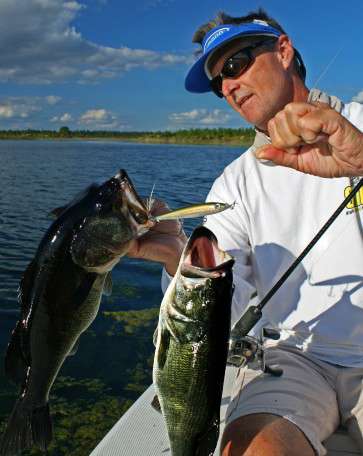
Where I’m from, bass often study a lure before ever deciding to strike it. Florida-strain largemouth are notorious for this. In fact, the Sunshine State is where the expressions “dead-sticking” and “dead-worming” originated.
Our bass are sometimes so slow to react, anglers frequently cast right over big schools, never knowing they are there. And this can occur wherever Florida-strain bass are found.
Arguably, they’re the most cautious — or perhaps stubborn — of all the black bass species.
Fortunately, a long time ago, some anonymous angler figured out how to entice these lock-jawed largemouth into biting — simply by allowing a soft-plastic lure to lie motionless, sometimes for 30 seconds or more.
Well, did you know that same approach can work with a topwater plug?
By allowing a surface lure to remain stationary, you’d be surprised by how many additional fish it can attract. The key is patience. And it can work on all species of bass, including smallmouth — which are recognized more for making snappy decisions.
Live It, Learn It
Early in my career, I qualified for the All American Bass Championship on Kentucky Lake. With a first place payout of $100,000, it was (at that point) the biggest tournament of my career … and I wanted to win.
The time of year was late fall, and the lake was already at winter pool. Nearly everything was high and dry. Except for some scattered brush piles in less than three feet of water, there was almost nothing to throw at. And for a shallow-water fisherman like me, that brought serious concern.
You see, to that point, I had almost no experience on reservoirs. The few that I had fished featured an abundance of grass, and that was where I focused my efforts. Not this time, however. There was zero grass to be found.
So I went with what I knew — targeting that shallow brush. And I caught fish — good fish — using spinnerbaits and buzzbaits.
It was surprisingly easy. After discovering the right lures and presentation, I spent the rest of practice searching for as many brush piles as I could find. When the competition began, I knew exactly what I was going to do.
On Day 1, I ran the very same brush piles, zipping buzzbaits and spinnerbaits over and through each of them. And by weigh-in time I had enough to take the lead in my division.

That night, while rigging my tackle, I heard the weatherman warn of an approaching cold front. But I wasn’t about to be deterred. My mind was set squarely on the same game plan. (Remember, this was my first exposure to a true northern reservoir, and I had nothing to fall back on.)
The next morning, I awoke to freezing temperatures and a stiff northerly breeze. Seeing that was sobering.
When I reached the first group of brush piles — those I had the most confidence in — not a single fish responded. Concerned, I switched to a shallow-running crankbait, then a jig, and finally some soft-plastics. Still nothing.
Eventually I moved on to some other brush piles, alternating these same lures … just trying to get a bite.
The Turning Point
Finally, with no fish and nowhere else to go, I made one last lure change: I decided to try a topwater walking bait.
I cast the lure to the next few brush piles to no avail. Then, in a last-ditch effort, I walked the bait up to a piece of brush and let it lie motionless. Maybe 15 to 20 seconds passed when, suddenly, a 3 1/2 pounder crushed the lure. On the very next cast to the same brushpile, another 3 pounder attacked the bait … but not before letting it lie still for nearly 30 seconds.

At that point, I knew I had them figured out. In the remaining 2 hours of the day, I retraced my steps and put fish after fish in the boat. And by weigh-in time, I had nearly 20 pounds of bass — enough to win my division and a brand new, fully-rigged Ranger bass boat!
If not for my exposure to dead-sticking soft plastics back home, I would never have made the necessary adjustments with the topwater lure on Kentucky Lake. And since that time, this same presentation has proven effective in countless situations.
Just like dead-sticking a soft-plastic, a stalled topwater hovering above a fish is sometimes more than it can resist. The strike may be a long time in coming, but it’s usually vicious when it occurs. And the grade of fish you’ll catch is usually much better than average.





